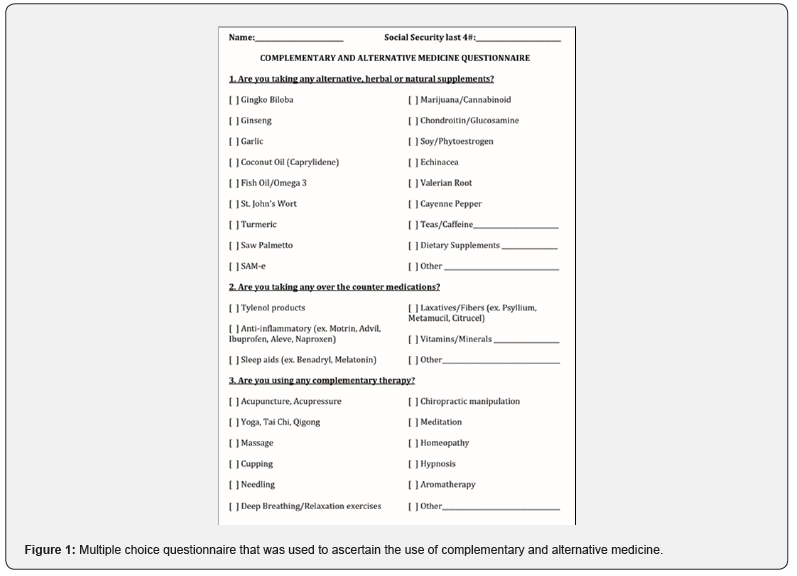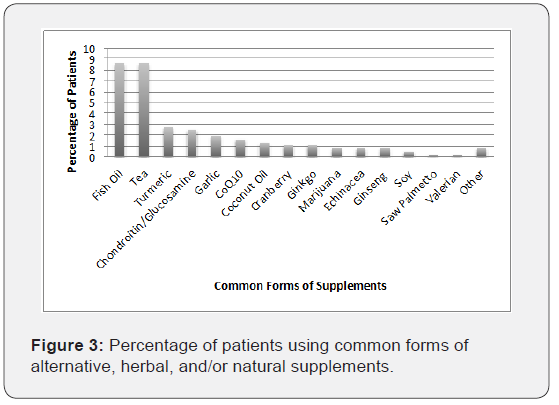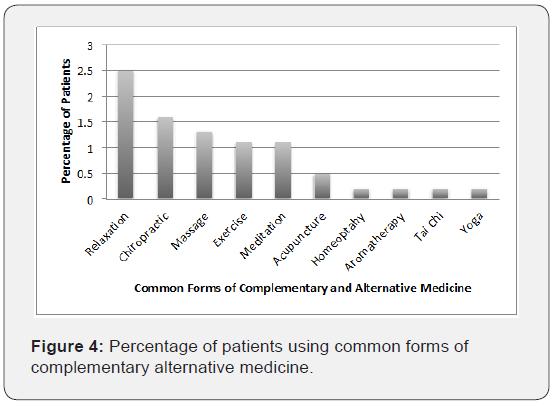Quality Improvement Project to Detect Use of Complementary and Alternative Medicine (CAM) in Patients at the Sepulveda VA Geriatric Medicine Clinic- Juniper Publishers
Juniper Publishers- Journal of complementary medicine
Abstract
Background/Objectives: The purpose of this
project is to identify complementary and alternative medicine (CAM) use
by patients seen at the VA Sepulveda ambulatory care center geriatric
clinic. Failure to disclose CAM use to primary care providers may result
in adverse interactions with prescribed medical treatments. We hope to
increase detection of CAM use, and thus improve the safety of our
patients by reducing potentially harmful polypharmacy.
Design: Survey study design.
Setting: VA Sepulveda ambulatory care center geriatric clinic in Los Angeles, CA.
Participants: 137 veterans, majority males, 65 years and older seeing the geriatric medicine team between October 2017 and February 2018.
Measurements: Geriatric clinic nurses provided
patients and/or their caregivers a one-page questionnaire asking about
to use of CAM while patients checked in to clinic. Once the
questionnaire was collected, the geriatric fellow reviewed whether or
not the questionnaire was appropriately documented in the electronic
medical record.
Results: Out of 137 patients who were seen at
the VA Sepulveda geriatric clinic, 115 patients use some form of CAM.
56.2% of the CAM were over-the-counter medications, 34.2% alternative,
herbal or natural supplements and 9.4% complementary therapy. 54% of the
CAM were not documented in the EMR.
Conclusion: The vast majority of the patients
at the VA Sepulveda geriatric clinic use CAM and more than 50% were not
documented, resulting in potential adverse interactions. Our goal is to
encourage discussion about CAM in order to prevent medical complications
arising from interactions between prescribed medications and CAM
treatment, thereby improving patient safety.
Keywords: Complementary and alternative medicine; Older adults; Polypharmacy
Introduction
The purpose of this project is to identify
complementary and alternative medicine (CAM) use by patients seen at the
VA Sepulveda ambulatory care center geriatrics clinic.
About 50% of older adults use some form of CAM in
the US and more than 40% of these patients do not disclose it to their
primary care provider [1,2]. The use of CAM among older adults, and
adults in general, is increasing each year. Failure to disclose CAM use
to primary care providers may result in adverse interactions with
prescribed medical treatments.
This subject is predominantly relevant in the older
population because they use more medicines overall and complementary and
alternative medicine compared with younger patients [2-4]. Among the
many reasons patients decide to incorporate CAM into their conventional
medical management is the dissatisfaction with the lack results of their
current treatment along with many adverse effects. Other reasons
include increased compatibility with their own cultural beliefs and
values regarding their own health, as well as more autonomy regarding
their well-being [3,4].
Although the older population is a little more
conscious about the health-related issues among CAM, they still need
education and awareness about the side effects that come along with this
type of treatment [2]. Herbal medicine, for example, is commonly used
among our population and many patients are not aware about its potential
harm [3,5].
We hope to increase detection of CAM use and improve
safety of patients by reducing potentially harmful polypharmacy and
identify possible side effects.
Methods
Two geriatric clinic nurses gave patients and/or caregivers
the one-page questionnaire asking about use of CAM (Figure 1)
before the clinic encounter. Once the questionnaire was collected,
the geriatric fellow reviewed whether or not the answers were
documented in the patients’ charts. We used the Institute for
Healthcare Improvement Model of Improvement, commonly
known as the Plan-Do-Study-Act cycle and reviewed the results
after 5 months of data collection starting in October 2017 and
ending in February 2018. Descriptive statistics were used to
analyze the data.

Results
At the VA Sepulveda geriatric clinic, 137 patients were
evaluated, 126 of whom were male and 11 were female. Out
of these 137 patients, 115 patients use some form of CAM.
56.2% of the CAM were over the counter medications; the
most common being vitamins, acetaminophen and laxatives
(Figure 2). 34.2% of the CAM were alternative, herbal or natural
supplements, most commonly fish oil, tea, and turmeric (Figure 3).
Relaxation, chiropractic services, and massage therapy comprised
approximately 9.4% of CAM (Figure 4). The most common CAM
used overall was vitamins, followed by acetaminophen, laxatives,
fish oil, tea, and melatonin. Unfortunately, 54% of the CAM were
not documented in the electronic medical record.



Discussion
The vast majority of the patients at the VA Sepulveda geriatric
clinic use CAM and more than 50% were not documented in the
electronic medical record or communicated to their primary
care provider. This can lead to adverse outcomes and potential
drug-drug interactions. In this study, we included over-thecounter
medications as patients will often self-treat with these
medications as alternative therapy, without consulting their
physician, not knowing the potential harm of these therapies if
not used appropriately.
In our quality improvement project, the most commonly used
CAM were vitamins, 23.6%. Unfortunately, this study was limited
by not identifying the specific type of vitamins that patients were
taking; it was assumed that the majority of these vitamins were
daily multivitamins. Vitamins were followed by acetaminophen
and laxatives in terms of the most commonly used over-thecounter
CAM. This was closely followed by fish oil and teas.
According to the National Center for Complementary and
Integrative Health (NIH), in 2007, the most popular products used
among adults were fish oil/omega 3, glucosamine, Echinacea, and
flaxseed [6].
A national study from 1998 of over one thousand individuals
reported that the most common CAM as chiropractic modalities,
diet, exercise and movement, and relaxation [3]. The findings
of this study were further confirmed by a study from 2005 that
included over one thousand patients. Of these one thousand
patients, 88% of respondents, over the age of 65, used dietary
supplements and chiropractic modalities most frequently [1].
In the United States, the use of CAM in the US is more
prevalent than formerly reported [2,4,7]. It is most frequently
used in patients that have been educated with a holistic emphasis
and those who have had a transformational experience, most often
with a poor health status [3,8].
The goal of this study is to encourage discussion about CAM
with the hope of preventing medical complications arising from
interactions between prescribed medications and CAM treatment.
This will improve patient safety. Further studies should be
conducted to evaluate whether or not potential interactions
between prescribed medications and CAM are statistically
significant enough to warrant spending clinic time discussing CAM
use with our geriatric patients.
| https://juniperpublishers.business.site/ |




Comments
Post a Comment